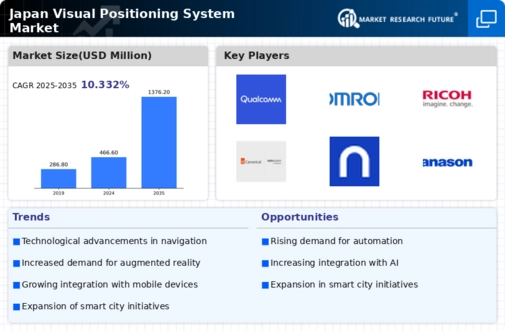The Japan visual positioning system market is currently experiencing a notable evolution, driven by advancements in technology and increasing demand for precise location services. This market encompasses a range of applications, including robotics, augmented reality, and autonomous vehicles, which are becoming increasingly prevalent in various sectors. The integration of visual positioning systems into these applications enhances operational efficiency and accuracy, thereby attracting significant interest from both businesses and consumers. Furthermore, the Japanese government's initiatives to promote smart city developments and technological innovation are likely to bolster the growth of this market. As urban areas continue to expand, the need for effective navigation and positioning solutions becomes more critical, suggesting a promising future for visual positioning technologies in Japan.
In addition to technological advancements, the Japan visual positioning system market is also influenced by cultural factors and consumer preferences. Japanese consumers exhibit a strong inclination towards high-quality, reliable products, which may drive manufacturers to prioritize precision and user experience in their offerings. Moreover, the increasing adoption of smart devices and IoT technologies in everyday life is expected to further propel the demand for visual positioning systems. As the market evolves, it appears that collaboration between technology providers and end-users will be essential in developing tailored solutions that meet the unique needs of the Japanese market. This collaborative approach may lead to innovative applications and enhanced functionalities, ultimately shaping the future landscape of visual positioning systems in Japan.
Technological Advancements in Visual Positioning
The Japan visual positioning system market is witnessing rapid technological advancements, particularly in the fields of artificial intelligence and machine learning. These innovations enhance the accuracy and efficiency of positioning systems, making them more appealing to various industries, including logistics and transportation.
Integration with Smart City Initiatives
The ongoing development of smart cities in Japan is significantly impacting the visual positioning system market. As urban planners and local governments invest in infrastructure that supports advanced navigation and positioning technologies, the demand for these systems is likely to increase, fostering a more connected urban environment.
Consumer Demand for Precision and Reliability
Japanese consumers prioritize high-quality and reliable products, which influences the visual positioning system market. This demand drives manufacturers to focus on developing systems that offer enhanced precision and user experience, ensuring that products meet the expectations of discerning consumers.



















